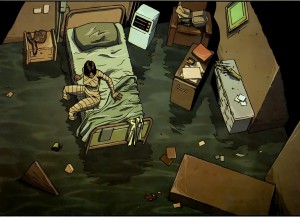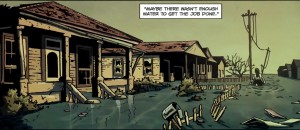Nola
Publisher: Boom! Studios
Creator: Chris Gorak
Writer: Pierluigi Cothran
Artist: Damian Couceiro
Hurricane Katrina was one of the worst natural disasters in American history, killing over1,800 people and flooding the city of New Orleans. But despite the scope of the disaster, there are surprisingly few comics about Katrina or its aftermath. Perhaps comic writers, who tend to be white, northern, and middle class, are simply indifferent to a disaster that mostly affected people who are black, southern, and poor. Or if I were to be more charitable, perhaps comic writers are trying to be respectful, given that Katrina is still a very recent tragedy from the survivors’ perspective. But if I’ve learned anything from my years of consuming pop culture, it’s that somebody will eventually find a way to turn even the worst disaster into a frivolous pulp thriller.
Which brings me to Nola, a 4 part mini-series created by Chris Gorak (an art designer for several big films) and written by Pierluigi Cothran (writer of several Heroes graphic novels). The story is about the oh-so-cleverly named Nola Thomas, an attractive African American woman who falls for a married man. Who’s rich, white, and named Chevis, so obviously he’s an asshole. In fact, he’s an asshole of Kennedyian proportions, because when he drunkenly flips his car off the road with Nola inside, he sets the car on fire and flees rather than get caught having an affair with a black woman. Of course, Nola survives but she’s badly burned.
Hurricane Katrina finally factors into the story while Nola is in the hospital. Abandoned by the medical staff, Nola wakes up in a flooded room, bandaged like a mummy in the tradition of horribly scarred noir heroes. After she discovers that her mother died in the hurricane, Nola decides it’s time to set the plot in motion and get her revenge. So she travels around the ruins of New Orleans, killing the doctor who left her to die, killing a few cops (it’s okay, they were jerks), and eventually hunting down Chevis. Along the way she also uncovers a rather convoluted murder mystery involving her long-lost father and another evil, rich white guy.
Ignoring the presence of Katrina, Nola is just an old-fashioned pulp crime story. It does occasionally touch upon race, but only in a shallow manner that helps advance the plot. And the colorful setting of New Orleans (pre-Katrina) is never used to its full potential. None of this is to say that Nola is awful, so much as it isn’t notably ambitious or original. Damien Couciero’s artwork, best described as generic, reinforces my impression of Nola as a by-the-numbers crime comic.
But the use of Katrina can’t be casually set aside. The plot hinges on the disaster in a number of ways: Nola is abandoned in the hospital because of the hurricane, her mother dies during the flooding, and she’s able to sneak around the city and get away with murder because law enforcement is already overwhelmed. The flooded landscape of New Orleans also give Nola a few memorable scenes, even if Couciero’s art is rather boring.
Most importantly, Katrina is a massive tragedy, and real-life tragedies can impart the illusion of relevance on otherwise irrelevant stories. Is it crass and shameless to use a real disaster to elevate low brow entertainment product? Yup, but Gorak and Cothran would probably insist that the personal tragedy of Nola is deeply interwoven with the larger tragedy that befell New Orleans. Because you see, Nola is scarred, just like New Orleans, and … um … Nola will never be the same again (after all the murdering and what not) and the city will never be the same again! It all makes sense, as long as you don’t think about it.
But if you do make the mistake of thinking about it, you’re left feeling dirty. It’s bad enough that so many people died while the government dithered, but Nola adds insult to injury by treating that catastrophe as a plot device for a trite revenge story.



I felt exactly the same way when I saw this book. As a black person myself, it’s not right. But I guarantee you that some studio(s) are probably jockeying for the film rights, which I’m sure is what this book was produced for in the first place.
I tend to be reluctant in accusing comic creators of making a comic just for the purposes of getting a film deal. But in this case, given that the creators have plenty of connections in Hollywood, it’s hard not to see this comic as anything other than a glorified storyboard.
Exactly, Richard.